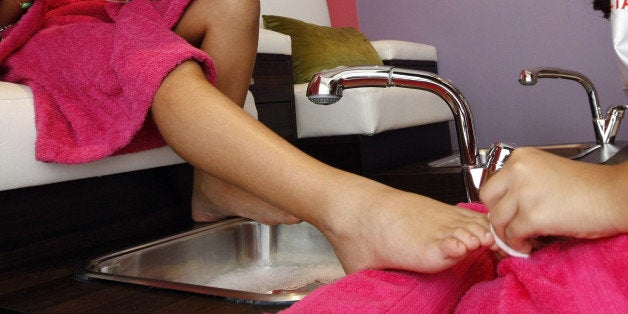
Spring has finally sprung, which means one thing: Pedicure season is upon us.
But all of that foot-centric primping and preening can quickly turn hazardous for your health. Before booking our first pedicures of the season, we talked to Dr. Jackie Sutera, a New York-based podiatrist, Dr. Ella Toombs, a dermatologist in Washington, DC, and Crystal Clements, the manager at Eve Salon in New York City. Here's what you need to know:
Never let them turn on the bubbles while you soak your feet.
Whatever you do at a pedicure salon, do not let the pedicurist turn on the bubbles in the foot baths. "The jets in the whirlpool bath can harbor bacteria and fungus," says Dr. Sutera.
Sutera estimates that she sees about 10 to 12 patients a week that come in with fungal or viral infections, like warts and athlete's foot, caused by build up in whirlpool foot baths. If the skin is cut by accident during a pedicure, you can also get bacterial infections by coming into contact with bacteria from previous customers at your station. She recommends finding a salon that uses pipeless foot baths or individual bath liners to further avoid cross-contamination with previous clients. Plus, make sure that your salon runs a sanitization cycle for the required minimum of 10 minutes between each client.
To be extra safe, Toombs suggests taking the time to dry the spaces in between your toes, too. "The moisture in those areas is where organisms like fungi and bacteria tend to grow," she says.
Make sure the metal tools they're using are sterilized between each client...
When you walk into a salon, look for tools soaking in that blue liquid disinfectant (a common brand is Barbicide). This effectively kills most microbial life that can lead to infection, in accordance with the Environmental Protection Agency's guidelines. Of course, some salons are better than others about cleaning, so make sure your pedicurist is using freshly sanitized metal tools on you.
Some salons might be using UV lights to sanitize tools -- you know, those machines that look like toaster ovens (not autoclaves, which kill 100 percent of infective organisms using high pressure and steam). But Dr. Sutera says that popping tools into one of those isn't a great way to sterilize. "It’s a six-hour process to sterilize instruments," she says. "You have to get them at really, really high temperatures; you have to soak them in different solutions; they have to be scrubbed. So putting them in that little toaster oven in between clients for a few minutes? I don't think that that's really doing much."
...and know the tools that should never be used for more than one client.
Any non-metal tools should be used on you and only you, since they're not sterilizable. Sutera tells her patients to bring their own nail files and foot pumices and sterilize them at home. Some salons give customers individual file kits, which include nail files, foot files, an orange wood stick and nail buffers, for each new pedicure client. You can then keep these tools and bring them back in to be used during your next pedicure. But again, staying alert is key here -- keep an eye on your pedicurist to ensure that you're not coming into contact with any used non-metal tools. "That's a big red flag," Clements says.
Tell your pedicurist exactly how to cut your toenails and cuticles if you want to avoid a trip to the doctor.
Toenails should be cut straight across along the contour of the nail -- never into the corners, since that will encourage the nail to grow into the skin and cause ingrown toenails. So make sure your pedicurist isn't cutting your toenails into rounded shapes. If you already have ingrown toenails, however, avoid pedicures entirely and see a podiatrist.
Unfortunately, there is no "right" way to cut cuticles, says Toombs. "The cuticle is very protective for the ultimate nail growth, but it's very thin tissue," she says. "If you're concerned about an infection, don't cut your cuticles, just keep them soft and pliant." You can do this by lubricating them often and gently pushing them back with a small orange wood stick.
Don't go in for a pedicure if you've just shaved your legs or if you have certain conditions.
If you're not in tip-top shape, you may want to reconsider getting a pedicure. "People who have compromised immune systems, such as diabetics, people with HIV, the elderly or anyone with vascular disease or circulation problems, are more at risk," Sutera says.
You're also more vulnerable for infections just after you shave your legs. By shaving, the razor creates microtears in the skin, which can allow bacteria to be introduced right into the legs. This can cause serious infections, like cellulitis. "You can literally end up in a hospital," Sutera says. She recommends waiting at least two days after shaving before going in for a pedicure.
Oh, and avoid those tempting manicure-pedicure deals.
Sutera says to never get the "Wednesday Special" -- you know, those discounted manicure-pedicure deals -- since they usually involve crowded salons and quick turnover. This, she says, doesn't always lead to the most thorough sanitization of foot baths and tools between clients. She also notes that weekends and evenings are typically busier in salons, so try to schedule an appointment for a weekday morning if you can.
"I know these are a lot of rules," says Sutera. "But I think in the long run, it's less expensive, less painful and much more enjoyable than visiting your podiatrist every week and dealing with infection and minor surgeries."
